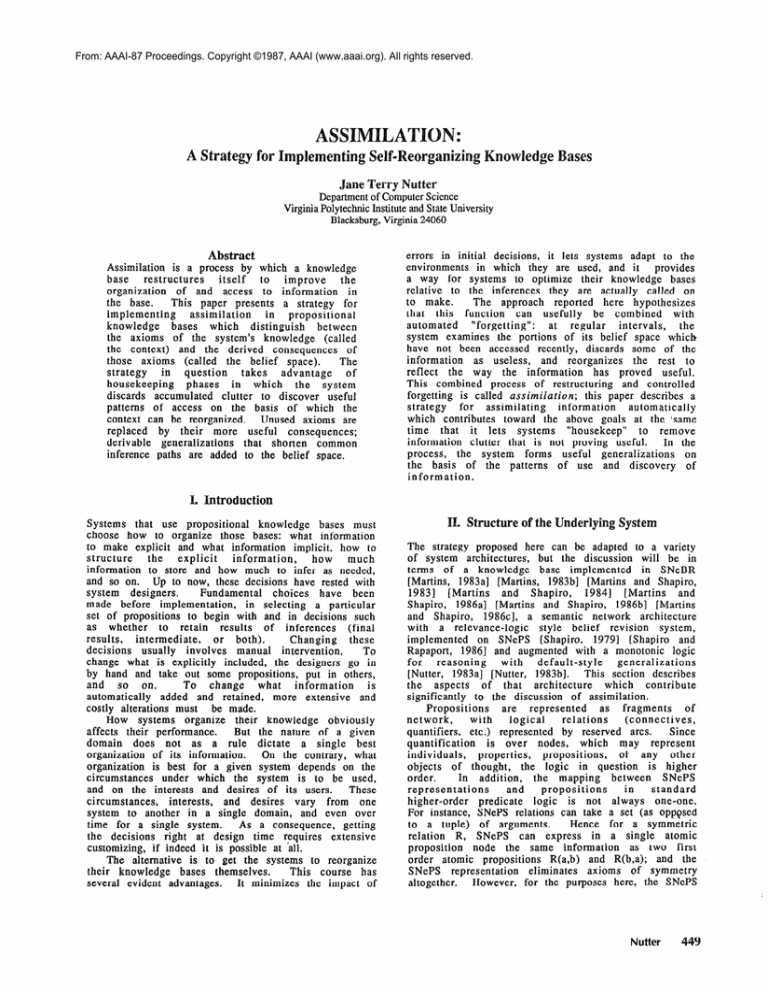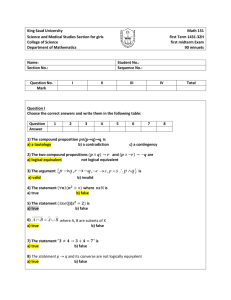
From: AAAI-87 Proceedings. Copyright ©1987, AAAI (www.aaai.org). All rights reserved.
A Strategy for Impleme
ases
Jane Terry Nutter
Department of Computer Science
Virginia Polytechnic Institute and State University
Blacksburg, Virginia 24060
Abstract
Assimilation
is a process by which a knowledge
base
restructures
itself
to
improve
the
organization
of and access to information
in
the base.
This paper presents
a strategy
for
implementing
assimilation
in
propositional
knowledge
bases
which
distinguish
between
the axioms of the system’s knowledge
(called
the context)
and the derived
consequences
of
those axioms (called the belief space).
The
strategy
in
question
takes
advantage
of
housekeeping
phases
in which
the
system
discards
accumulated
clutter to discover
useful
patterns
of access on the basis of which the
context can be reorganized.
Unused axioms are
replaced
by their more useful
consequences;
derivable
generalizations
that shorten
common
inference paths are added to the belief space.
errors in initial decisions,
it lets systems adapt to the
environments
in which they are used, and it
provides
a way for systems to optimize their knowledge
bases
relative to the inferences
they are actually called on
to make.
The approach
reported
here hypothesizes
that this function
can usefully
be combined
with
automated
“forgetting”:
at regular
intervals,
the
system examines the portions of its belief space which
have not been accessed recently, discards some of the
information
as useless,
and reorganizes
the rest to
reflect
the way the information
has proved
useful.
This combined
process of restructuring
and controlled
forgetting is called assimilation;
this paper describes a
strategy
for
assimilating
information
automatically
which contributes
toward the above goals at the ‘same
time
that it lets
systems
“housekeep”
to remove
information
clutter that is not proving useful.
In the
process,
the system
forms useful generalizations
on
the basis of the patterns
of use and discovery
of
information.
1. Introduction
Systems
that use propositional
knowledge
bases must
choose how to organize those bases: what information
to make explicit and what information
implicit, how to
structure
the
explicit
information,
how
much
information to store and how much to infer as needed,
and so on.
Up to now, these decisions have rested with
system
designers.
Fundamental
choices
have been
made before implementation,
in selecting
a particular
set of propositions
to begin with and in decisions such
as whether
to retain
results
of inferences
(final
results,
intermediate,
or both).
Changing
these
decisions
usually
involves
manual
intervention.
To
change what is explicitly included, the designers
go in
by hand and take out some propositions,
put in others,
and
so
on.
To
change
what
information
is
automatically
added and retained,
more extensive
and
costly alterations must
be made.
How systems
organize
their knowledge
obviously
affects their performance.
But the nature of a given
domain
does not as a rule dictate
a single
best
organization
of its information.
On the contrary, what
organization
is best for a given system depends on the
circumstances
under which the system is to be used,
and on the interests
and desires of its users.
These
circumstances,
interests,
and desires
vary from one
system to another in a single domain, and even over
time for a single system.
As a consequence,
getting
the decisions
right at design time requires
extensive
customizing, if indeed it is possible at ‘all.
The alternative
is to get the systems to reorganize
their knowledge
bases themselves.
This course
has
several evident advantages.
It minimizes
the impact of
The strategy proposed here can be adapted to a variety
of system architectures,
but the discussion
will be in
terms of a knowledge
base implemented
in SNeBR
[Martins, 1983a] [Martins, 1983b] [Martins and Shapiro,
19831 [Martins
and Shapiro,
19841 [IMartins
and
Shapiro,
1986a] [Martins and Shapiro, 1986b] [Martins
and Shapiro,
1986~1, a semantic
network
architecture
with a relevance-logic
style belief
revision
system,
implemented
on SNePS [Shapiro,
19791 [Shapiro
and
Rapaport, 19861 and augmented with a monotonic
logic
reasoning
generalizations
for
with
default-style
[Nutter, 1983a] [Nutter, 198381.
This section describes
the
aspects
of that
architecture
which
contribute
significantly
to the discussion
of assimilation.
Propositions
are
represented
as fragments
of
network,
with
logical
relations
(connectives,
Since
quantifiers,
etc.) represented
by reserved
arcs.
quantification
is over nodes,
which
may represent
individuals,
properties,
propositions,
of any other
objects
of thought,
the logic in question
is higher
the mapping
between
SNePS
order.
In addition,
standard
representations
propositions
in
and
higher-order
predicate
logic is not always
one-one.
For instance, SNePS relations can take a set (as oppgsed
I-Ience for a symmetric
to a tuple) of arguments.
relation
R, SNePS can express
in a single
atomic
proposition
node the same information
as two first
R(a,b) and R(b,a); and the
order atomic propositions
eliminates
axioms
of symmetry
SNePS representation
However, for the purposes here, the SNePS
altogether.
Nutier
449
representation
can be treated
as equivalent
to a
representation
in standard
logic
(first
or higher
order),
augmented
by a capacity
for representing
default
generalizations.
The default reasoning
system introduces
a logical
operator
p, which takes a proposition
or formula and
marks
it as uncertain
(p can be read roughly
as
“presumably”).
For the purposes
here,
the only
significant
rule about p is that p’s
are “inherited”
through
inferences.
That
is,
suppose
that
a
proposition
+
can be inferred
from
a set of
propositions
w = (Wl,...,Wn),
and suppose that for 1 5 i <
n, vi’ = vi or Wi’=pWi. Then from W’ = (Wl’,...,Wn’} the
system can infer p$.
For a discussion of the default
logic, see [Nutter, 1983a].
The belief revision system introduces
the concepts
of contexts
and belief
spaces.
A context
is a set of
propositions
taken
as hypotheses
which
form
the
deductive
basis of a belief space, and which may be
thought
of as the axiom set of a potential
agent’s
beliefs.
The belief space
associated
with a given
context
contains
all propositions
which
have been
deduced from that context.
The belief space does not
automatically
include
all propositions
entailed
by the
context,
since
agents
are taken
as knowing
(or
believing)
only those
propositions
actually
inferred
(and
those
trivially
subsumed
by
them).
As
propositions
are deduced from hypotheses
in a context
and other members
of the associated
belief
space,
those
propositions
not
trivially
subsumed
by
propositions
already present
are added to the belief
space, along with other propositions
proved along the
way.
Propositions
may belong to several belief spaces,
i.e., the belief
spaces of different
contexts
can and
frequently
will overlap.
In addition to modeling
the
system’s beliefs
and beliefs
of other agents, contexts
provide settings for hypothetical
reasoning,
and so on.
At any given time, there is a distinguished
context
called the current
context
(CC), which contains
the
hypotheses
of the system’s belief space.
This is the
context we will be most concerned with here.
Propositions
in a belief
space
have
associated
deductive
histories
(one for each deduction
which had
the proposition
as its conclusion).
Each deductive
history
includes
a record
of
the
proposition’s
set-of-support,
which is the list of hypotheses
actually
used in deriving
the conclusion
in that particular
deduction
(where a previously
proved proposition
,A is
used,
the set-of-support
includes
A’s set-of-support,
not A itself).
Belief spaces can be identified
using
sets-of-support:
a proposition is in the belief space of a
context C provided that it has at least one deductive
history whose set-of-support
is a subset of C.
The assimilation
strategy
proposed
here, then, is
targeted
on systems
whose knowledge
base can be
construed
as having the structure
given in figure
1.
The effect of assimilation
will be to alter both the
contents and the structure of the CC and its associated
belief space.
o Assimilation
and Forgetting
The essential idea behind this approach to assimilation
is to make use of internal
housekeeping
cycles
for
discarding
“clutter”.
The architecture
described
above
450
Knowledge Representation
Knowledge Base
Figure 1. Structure of the Knowledge Base
saves not only all results of deductions
(answers
to
user questions,
for instance),
but also all
top-level
intermediate
results not trivially
subsumed
by known
say that the CC contains
For instance,
propositions.
representations
for the propositions
V x(Bird(x)
3,
v x(Ostrich(x)
1
Bird(x))
and
Has-feathers(x)),
Ostrich(Oscar),
and suppose that the system is asked
Upon completing
the
whether
Oscar has feathers.
the system
will add a representation
of
deduction,
For questions
Has-feathers(Oscar)
and Bird(Oscar).
these
realistic
amounts
of inference,
that
require
results
can increase
the size
of the
intermediate
knowledge
base significantly.
The system could simply choose not to add the
intermediate
results, but then it will have to repeat the
sometimes
quite long ones.
same chains of reasoning,
In other words, the question
whether
to retain these
a classic
time-space
intermediate
results
represents
trade-off,
in this case a choice between
reinventing
the wheel
and remembering
everything
the system
The ideal answer
has ever known, however
trivial.
would be to retain only those results which the system
The
will actually want and find useful in the future.
key idea here is that these may be easier to identify in
retrospect
than in advance,
and identifying
them in
retrospect
can be worthwhile.
Suppose
that
the
system
time-stamps
every
proposition
in the knowledge
base every time that the
here
means
(“Accessed”
proposition
is accessed.
in a set-of-support
actually
used, not just involved
also that a
Suppose
for instance.)
manipulation,
latency time period t is chosen to reflect “recent use”.
Then at regular
intervals,
the system
can scan for
which
have not been accessed
in the
propositions
period from now - t to now. One simple rule would be
if these propositions
do not belong to
the following:
constitute
clutter
and can be
they
the CC, then
forgotten.
But not all clutter is useless.
For example, suppose
that an element of the CC has not been accessed in the
It may be that instead of using that
latency time.
proposition
in making deductions,
the system is using
other
members
of the belief
space
which
in fact
Those other members of the
shorten deductive chains.
belief space may have been proved using the original
it cannot
simply
be dropped
without
hypothesis;
curtailing
the belief space and losing information
that
But it may be possible to replace
is actively in use.
in
that hypothesis
by one or more of the propositions
That is, the fact that an hypothesis
the belief space.
has not been used in a while may show that the
is less
efficient
than
an
axiomatization
current
This
alternative
provides
a
available
alternative.
restructuring
of the belief
space
to adapt to the
environment.
system’s
Even unaccessed
propositions
in the belief
space
For
but outside the CC may not be simple clutter.
instance,
suppose
that the system
has unaccessed
propositions
of the form f(a) for different
instances of
a. If the system does not contain Vxf(x), and if that is
That is, instances
of
true, maybe it should add it.
concrete
propositions
of the same form may reflect
frequently
followed
paths of inference
which can be
shortened.
the balance
of time wasted
on
So to optimize
space
wasted
on useless
inferences
versus
repeated
the system
performs
controlled
forgetting,
results,
checking first that no crucial information
will be lost.
But before
simply
forgetting
any single
item, the
it indicates
a
system
reflects
on it to see whether
useful restructuring
or other adaptation
of the belief
It is this reflection
and consequent
altering
space.
and restructuring
which constitute
assimilation.
IV. The ~Ssimi~atiQ~ §trategy
Select a latency time t to represent the longest period
for which a proposition
may be unused without being
On each
considered
for assimilation
or forgetting.
the
system
scans
through
the
assimilation
cycle,
knowledge base to form the set Q = {@1,. . . ,$I I for 1 I i I
n, Q,i has not been accessed
for at least t long];
propositions
in 0 are called stale.
Because the strategy
is sensitive to the order in which the members of $ are
they are ordered
with the most recently
considered,
I
accessed last. That is, for i c j, time-of-last-access(@i)
For each $i, there are three
time-of-last-access(+j).
possibilities:
@i is in the CC, Cpi is not in the CC but is in
the system’s belief space, or Qi is in neither the CC nor
We these up in turn.
the system’s belief space.
A.
+iisintheCC
Either @i can be proved from CC - $i or it cannot. If it
can, then it can be dropped without loss, since any
inferences
which can be made using it can also be
Before
they are.
made without
it, and apparently
must find any
dropping
9 i, howyheer, the system
whose
in
space
in
belief
propositions
and replace
it in those
set-of-support
4 i occurs
sets-of-support
by the set-of-support
of the proof of Qi
(In SNeBR, finding these propositions
is
from CC - $i.
simply
checking
for a link, and does not require
Implementations
on
scanning
the knowledge
base.
The
other systems may involve a higher search cost.)
system
can then forget
$ i (i.e. delete it from the
This is the provision
which makes
knowledge
base).
the order in which stale propositions
are considered
Suppose that $i and Qj both belong to CC. Then
matter.
it may be that @i can be inferred from CC - @i and that
Cpj can be proved from CC - @j, but $i cannot be proved
from CC - {@i,Qj} and neither can oj. In this case, only
Since the one considered
first
one can be forgotten.
will be the one forgotten,
the one that has gone
unused longer should be considered
first.
In the second and more interesting case, Qi can not
be derived from CC - Cpi. Either Qi occurs in one or more
sets-of-support,
or it does not.
If it doesn’t, then it
seems reasonable to forget it: if the system has never
needed this piece of information
before, it is unlikely
to do so later.
(Hypotheses which are anticipated to be
needed
rarely
but crucial
when they
are can be
flagged to prevent deletion.)
A slightly more liberal
strategy would drop Qi provided that it occurs only in
the sets-of-support
of stale propositions;
this effect
can be obtained by ordering $ so that all members of
the system’s belief space that are not in the CC come
before any that are.
If Qi can not be proved from CC - $i but does occur
in sets-of-support,
it may still be inferrable
from the
belief space.
Since everything in the belief space that
is not in CC can be inferred from it, the only beliefs
not in CC that we have to consider are those with oi in
their
set-of-support.
Let B(Qi) = {pv I w is in the
system’s
belief
space,
w e @, and Cpi is in the
set-of-support
of a~], and consider CC’ = CC u B(@i) - $i.
Suppose that @i can be proved from CC’. This means
that CC’ contains the information
of Qi, in a form that *
the system finds more useful: it is actually accessing
the members of B(@i), but not $i itself.
Suppose there is only one proof of @i from CC’. Let
B’($i) be the subset of B($i) appearing in the set-ofsupport of that proof.
Then add B’(Qi) to CC, replace $i
by B’($i) in all sets-of-support,
and forget Qi.
This
restructures
the CC to adapt to the actual pattern of
use.
Suppose on the other hand that there are several
proofs of Qi from CC’ and that they have different
Then the system must choose
associated
sets B’(@i).
which propositions
in its belief space to elevate to the
The system could choose the smallest set.
This
cc.
corresponds
to the principle that axiom sets should be
kept as small as possible, and so favors space over time.
Alternatively,
it could choose the set whose elements
collectively
have
the
largest
number
of recent
This is the more
interesting
option,
references.
because
the more adaptive:
it adds the propositions
most used and hence presumably most useful.
It is also
small
possible
to combine these, to select a relatively
set with relatively
high usefulness.
. $i is in the
system’s
not in the CC
belief
space
but
Before forgetting
stale members of the system’s belief
space, the system checks whether they suggest useful
generalizations.
Suppose that Qi contains at least one
Check the belief space for other
individual
constant.
differ
from
+ i only in
propositions
Q i’ which
individual constants.
(In the case of SNeBR, this check
little
because
the propositions
in
costs
relatively
question
share
structure
with
Qi
at $1 relational
constants.
In other specific
architectures,
it may be
If other such $ i’ exist,
form the
more costly.)
all individual
constants
proposition
fi* by replacing
that the @i’ do not hold in common by variables and
then quantifying
universally
over those variables.
If
in the system’s belief space, do netting
Qi* is already
If it is not, try to deduce it, and if
at this point.
If $i* can not be
successful, add it to the belief space.
deduced, try to deduce p$i* .
Next, check Q, for other propositions
which have at
least one individual constant in common with $i. For
Nutier
451
each such $ j, consider the pair {q i,$ j } and look for
pairs {@i’,$j’) where oi’ corresponds to $i as above, Qj’
to
+ j, and @ i’ and $ j’ share
the
corresponds
Let @j = Qi 3 Qj, Qji = +j 3 $i,
corresponding constant.
$ipj = $i I> p$j, and Qjpi = $j 3 p$i, and form $ij*, $ji*,
These represent hypotheses
@i:tt and Qjpi* as before.
“if-then”
unrversal
rules
(and corresponding
might
which
shorten
generalizations)
default
Try to deduce each of these from the
inference paths.
CC; any which can be deduced should be added to the
Finally,
forget $i and any of the Qi’
belief
space.
which are also in Cp and not in the CC.
C. Qi is
belief
in
neither
space.
the
CC
nor
the
system’s
In this case, $i is important to the system only if it is
For
in a belief space which the systems “cares about”.
to have
entered
the knowledge
base
without
9i
belonging
to the system’s belief space, one of several
Either it was once in the
things must have been true.
belief space but left it because
at least one of the
hypotheses
in the set-of-support
for $i was dropped
from the CC (not forgotten, but found to be false), or $i
was deduced
in the course of a deduction
involving
or +i was deduced
in the
hypothetical
reasoning,
course of reasoning about some other agent’s beliefs.
If $i was involved
in hypothetical
reasoning,
and
if the context relative to which +i was deduced
(or
hypothesized)
often matters to the system, the system
may want to protect that context by flagging it in such
a way that the rules for assimilating
information
in
to that
the system’s belief
space also hold relative
This amounts to saying that
context’s belief space.
situations
matter
enough
to the
some
hypothetical
information
about
system that it is worth maintaining
them the same way that it is maintained
about (what
Likewise,
the system regards as) the actual situation.
if $i belongs to the context or belief space of another
agent about whom the system frequently
must reason,
If $i
the context for that agent may also be protected.
is an hypothesis
of an unprotected
context, forgetting
Qi involves
also forgetting
propositions
in whose setThe
strategy
therefore
of-support
$r i figures.
in every
forgetting
prohibits
cpi if it occurs
set-of-support
for one or more propositions
not in $,
since
the existence
of such ‘non-stale
propositions
indicates
that the context,
although
unprotected,
is
still active. In all other cases, if $i does not belong to
the belief
space of any protected
context
(including
the CC), it can simply be forgotten.
V. Discussion
A.
Information
Loss
Most of the strategy outlined above is straightforward
implementation.
in
and
implications
both
in
decisions
surround
instances
Potentially
controversial
is actually
lost.
of forgetting
in which information
These
arise whenever
something
is forgotten
which
cannot
be deduced
from its context,
that is, when
This
are dropped.
hypotheses
of active
contexts
cannot be derived
happens
when a stale hypothesis
452
Knowledge Representation
from the rest of the its context and has no “fresh”
consequences.
In the case of the CC, the rationale for forgetting
the hypothesis
is that if it hasn’t been needed yet, it
probably won’t be.
How good this rationale is depends
on how long the system has been around: in the early
phases of system use, some areas may simply not have
been got to yet.
It follows that it may be reasonable to
have
a second
latency
time tc which
is checked
before a stale hypothesis in the C!C is discarded.
That
is, to determine
whether the hypothesis
is stale, the
same threshhold
is used as for any other proposition.
But before
discarding
the hypothesis,
the system
checks whether the hypothesis
has been latent longer
than tee The more conservative
the system, the longer
t
should be.
Alternatively,
protection
can be taken
a”s” absolute
for hypotheses:
they can be replaced
by
other propositions
so long as they remain deducible,
but in no case can they be forgotten
without being
reconstructible.
For
hypotheses
of
unprotected
contexts,
the
rationale
for forgetting
the information
is that it is
the only way to get rid of outdated contexts.
Since
hypothetical
contexts
arise routinely
in the course of
reasoning
with certain inference
rules, it is desirable
to be able to get rid of them later: contexts
and
intermediate
conclusions
which existed
only in order
to work through
a single
proof-by-cases
constitute
true clutter,
and should be forgotten.
The price for
this is that if for any reason a context which should be
protected
isn’t,
information
about
it
may
be
irretrievably
lost.
B.
Extensions
of
the
Strategy
The strategy
can be extended
in several
interesting
The most intriguing possibility
occurs when $i
ways.
belongs to CC, and when Qi can almost be inferred
from CC’, but not quite.
That is, most of the
information
of 9i has been captured
by inferences
already made, but there is some $i+ which is not there.
What
we would
like the system
to do is find
simultaneously
the weakest
and the most interesting
+ip such that CC’ + $it entails $i. The system would then
add Qi t and the appropriate
B’($i) to CC, making the
correct alterations
to sets-of-support
and forgetting
0 i.
The obvious
problem
here is to get the system
to
Other options
include finding
more
formulate
@it.
sophisticated
patterns
in stale
instances
than
the
simple
implications
described
above,
and considering
information
as
should
take
when
the
system
even
when
it
suggesting
(default)
generalizations
can’t prove them.
c.
Computational
Cost
of
the
Strategy
Despite the features of SNePS and SNeBR mentioned
above which reduce search costs, assimilation
passes
Worse, their cost rises
are obviously very expensive.
rapidly as the number of stale propositions
increases,
since the amount of inference
required grows rapidly.
This might seem to suggest that passes should be run
frequently (at least relative to t), to hold down the size
the usefulness
of each pass also
Unfortunately,
of 0.
increases in proportion to the size of @. This suggests
that passes should be infrequent,
ideally off-line or at
The
very low use times, and that t should be large.
latter
also follows
from the desire
not to discard
potentially
useful intermediate
results too quickly.
On
the
bright
side,
as
the
system
adapts
to
its
the number
of major
changes
should
environment,
reduction
in
in
a natural
decrease,
resulting
assimilation
cost.
[Martins and Shapiro, 1986~1 Jo50 P. Martins and Stuart
C. Shapiro.
Belief
revision
in SNePS.
In
Proceedings
Artificial
of the Sixth Canadian
Conference
on
Intelligence,
pages 230-234,
Montreal,
Quebec, Canadian Society for Computational
of Intelligence,
May 1986.
Studies
[Martins and Shapiro,
C. Shapiro.
A
The strategy
described
here provides
mechanisms
for
systems
to assimilate
information
in response
to the
actual patterns in which they have been called on to
use that information.
It allows
them to eliminate
clutter
while retaining
useful
intermediate
deductive
inferences
while
avoiding
results,
thus
repeating
More interesting,
it also
lessening
the cost in space.
lets them restructure
their belief
spaces,
promoting
important
derived
principles
to axiom
status
and
demoting
less
useful
axioms
to belief
status
or
This lessens the need for
forgetting
them altogether.
system
designers
to anticipate
the environment
in
which the system will be used (including
the precise
questions
it will be asked) by letting systems
adapt
their axiom structures
to their use environments,
and
within a single environment
to changes
in emphasis
over time.
The strategy is indifferent
to the area of
application,
and while it was designed for a particular
knowledge
base architecture,
it can be readily -adapted
to other
architectures
so long
as they
retain
an
essentially
axiomatic structure (that is, so long as they
have a distinction
between context and belief space).
general
approach
to
very
It
is
thus
a
area
of
particular
self-reorganization
in
the
information
assimilation.
Artificial
[Martins,
Intelligence,
1983b]
Multiple
Jogo
Belief
Belief
Martins.
of
the
1983
Rochester,
P.
[Martins and Shapiro, 19831 JoIo P. Martins and Stuart
C. Shapiro.
Reasoning
in multiple belief spaces.
In Proceedings
IJCAI-83,
pages 370-373, Karlsruhe,
Federal
Republic
of German,
International
Joint
Committee for Artificial Intelligence,
August 1983.
[Nutter, 1983a] Jane
using monotonic
Terry
logic:
Nutter.
Default reasoning
a modest
proposal.
In
pages 297-300, Washington,
Proceedings
AAAI-83,
Artificial
D.C.,
American
Association
for
Intelligence,
August 1983.
1983b] Jane Terry Nutter.
Default
Reasqning
Technical Report 204, Department
Systems.
of Computer Science, SUNY at Buffalo, October 1983.
[Nutter,
in A.I.
[Shapiro, 19791 Stuart C. Shapiro.
network
processing
system.
Findler,
Associative
editor,
Representation
Computers,
York,
and
pages
Use
179-203,
The SNePS semantic
In Nicholas
V.
of
Networks:
Knowledge
Academic
Press,
The
by
New
1979.
Stuart C. Shapiro and
[Shapiro and Rapaport,
19861
SNePS considered
as a fully
William J. Rapaport.
In
intensional
propositional
semantic
network.
Proceedings
AAAI-86,
pages 278-283,
Philadelphia,
American
Association
for Artificial
Pennsylvania,
Intelligence,
August 1986.
eferences
[Martins,
1983aJ Jolo P.
MBR. In Proceedings
19841 JoZto P. Martins and Stuart
model for belief
revision.
In
Reasoning
Non-monotonic
pages
Workshop,
241-294, New Paltz, New York, American Assocation
for Artificial
Intelligence,
October 1984.
Martins.
revision
Conference
Michigan,
Reasoning
Spaces.
Ph.D.
Technical
Report
203, Department
Science, SUNY at Buffalo, May 1983.
in
on
1983.
in
Dissertation,
of Computer
[Martins and Shapiro, 1986a] Jolo P. Martins and Stuart
Theoretical
foundations
for belief
C. Shapiro.
In Joseph Y. Halpem, editor, Theoretical
revision.
About
Knowledge,
pages
Aspects
of Reasoning
383-398,
Morgan Kaufmann Publishers,
Los Altos,
California,
1986.
[Martins
and
Stuart C.
Applications
Engineering
International
Southampton,
ADS
1986.
Shapiro,
Shapiro.
1986bJ JoIo
Hypothetical
P. Martins
reasoning.
and
In
Intelligence
to
Artificial
of
Problems:
Proceedings
of the First
Conference,
pages
1029-1042,
U.K.,
University
of
Southampton,
Nutter
453




